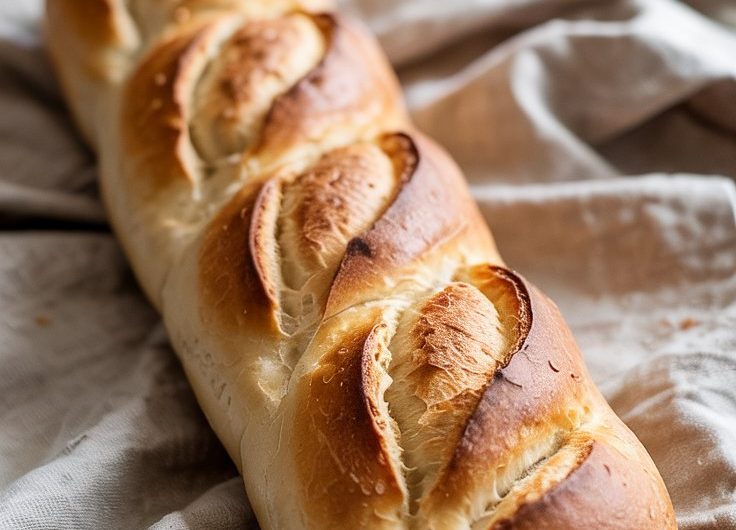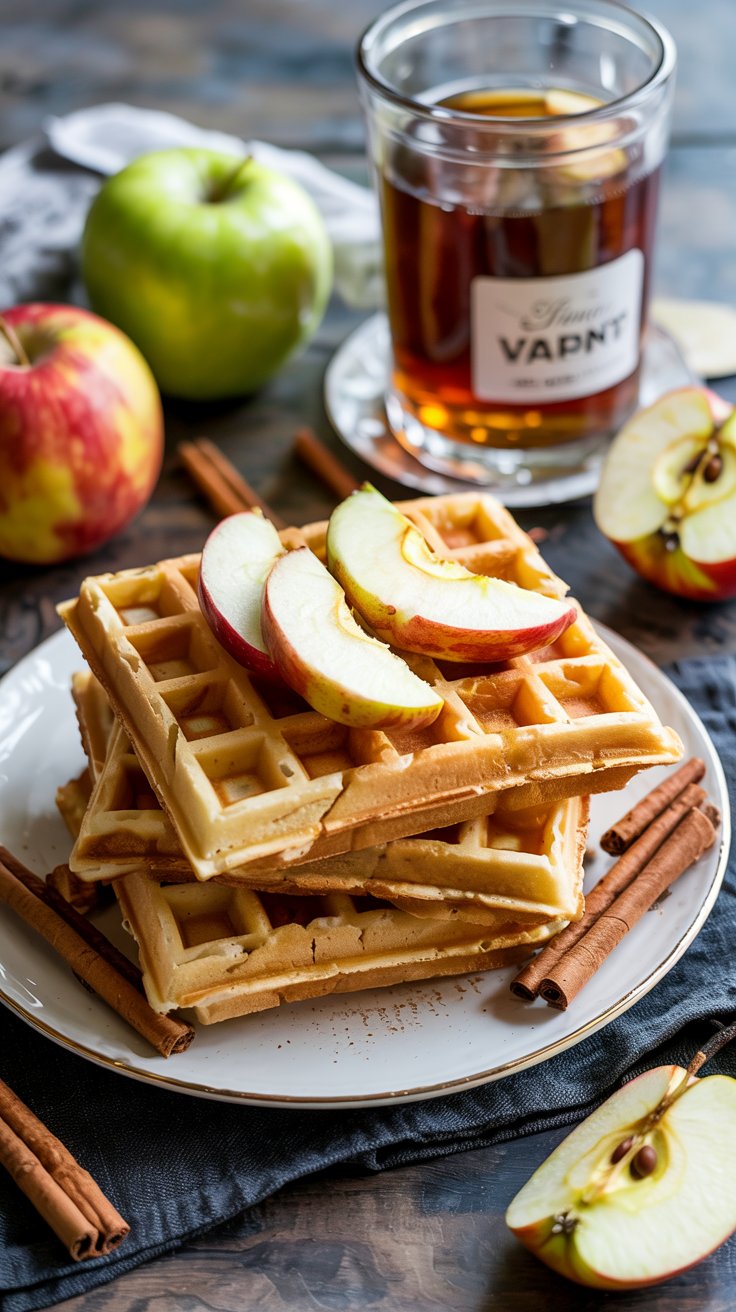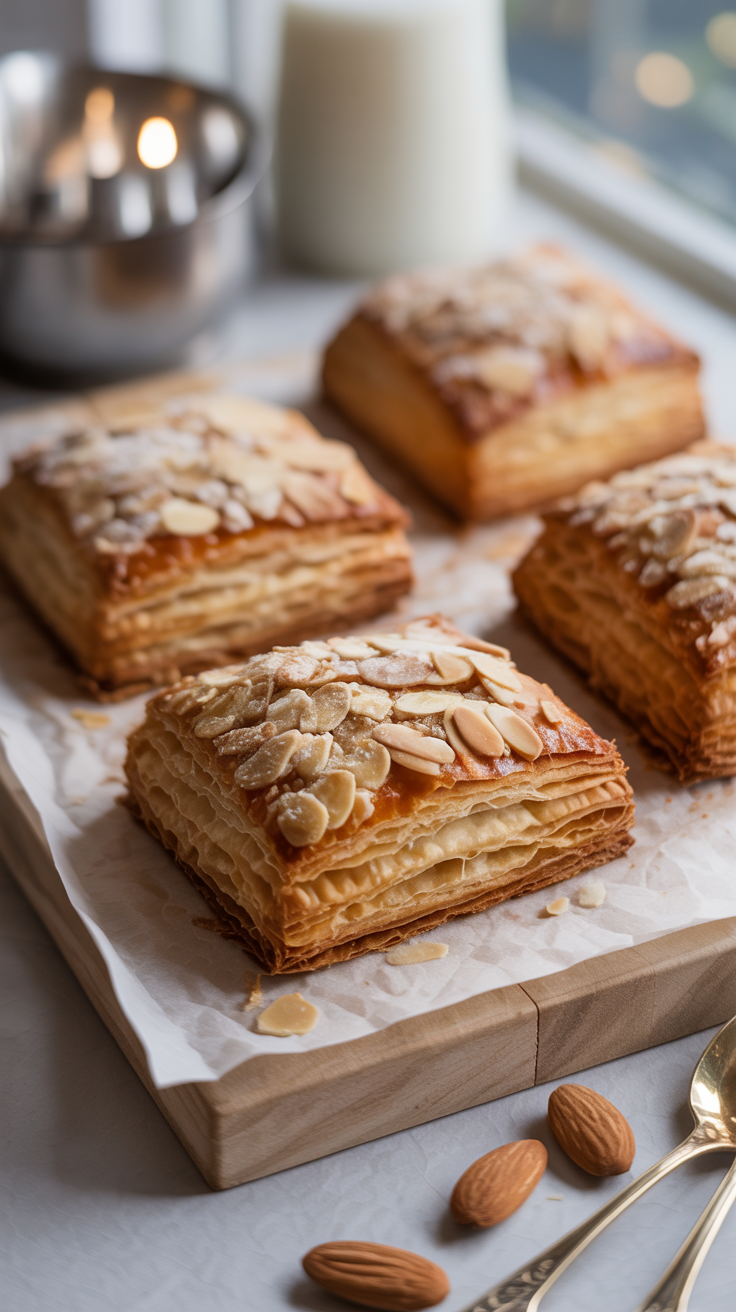Homemade French Bread
If you’ve ever wanted to bake a crusty, golden loaf that makes the whole kitchen smell like a cozy afternoon, Homemade French Bread is a wonderful place to start. It’s simple, honest bread—flour, water, yeast, and salt—yet the result feels special. The crackly crust, the tender crumb, the way a slice holds a swipe of butter or dips into soup without falling apart. No fancy gear required, just a bit of time and a gentle hand. This is the kind of recipe that fits into real life. You mix, you wait, you bake. And you enjoy it while it’s still slightly warm, when the crust sings as it cools (yes, it really does). Take a breath. You’ve got this.
Ingredients for this Homemade French Bread
- 3 1/2 cups (420 g) bread flour or all-purpose flour, plus extra for dusting
- 1 1/4 cups (295 ml) warm water (about 105–110°F / 40–43°C)
- 2 1/4 tsp (7 g) instant or active dry yeast (one packet)
- 2 tsp (10 g) fine sea salt
- 1 tsp (4 g) sugar or honey (optional, helps yeast wake up)
- 1 tbsp (15 ml) neutral oil or melted butter (optional, slightly softer crumb)
- Ice cubes or extra water for steaming the oven (optional but helpful for crust)
Notes: Bread flour gives a chewier loaf with bigger holes, while all-purpose flour bakes up a little softer. Either works. If your kitchen runs cold, the sugar or honey helps the yeast along, but you can skip it if you prefer a classic lean dough.
Instructions
Proof the yeast (if using active dry): In a small bowl, stir the warm water with the yeast and sugar. Let it sit 5–10 minutes until foamy on top. If using instant yeast, you can skip this and mix it directly with the flour, then add the warm water.
Mix the dough: In a large bowl, combine the flour and salt. Add the yeast mixture (or water if using instant yeast) and the oil if using. Stir with a wooden spoon until a shaggy dough forms. It’ll look rough—that’s okay.
Quick rest (mini autolyse): Let the dough rest for 10 minutes. This short pause lets the flour hydrate and makes kneading easier. Grab a sip of coffee, or just enjoy the quiet.
Knead: Turn the dough onto a lightly floured surface. Knead by hand for 8–10 minutes, or in a stand mixer with a dough hook for 5–6 minutes on medium-low. The dough should become smooth, elastic, and just slightly tacky. If it’s sticking like glue, dust in a teaspoon of flour at a time; if it’s tight and dry, sprinkle a few drops of water and keep going.
First rise: Place the dough in a lightly oiled bowl, turning once to coat. Cover with a clean towel or plastic wrap and let it rise at room temperature until doubled, 60–90 minutes. On a chilly day, set it near a sunny window or in a turned-off oven with the light on.
Shape: Gently deflate the dough and turn it out onto a floured surface. For a classic batard (oval loaf), flatten the dough into a rectangle, fold the top third down and the bottom third up (like a letter), then roll it into a tight log, pinching the seam shut. Taper the ends slightly for that French-bread look. You can also divide into two smaller loaves or shape into a baguette if you’re feeling fancy.
Second rise: Place the shaped loaf seam-side down on a parchment-lined baking sheet (or a floured tea towel if you have a baking stone). Lightly cover and let rise until puffy and slightly springy to the touch, 30–45 minutes. Not quite doubled, but noticeably fuller.
Preheat and steam setup: About 30 minutes before baking, preheat the oven to 450°F (230°C). If you have a baking stone or steel, preheat it too. Place an empty metal pan on a lower rack—this will be your steam pan.
Score: Just before baking, use a sharp knife or lame to make 3–4 diagonal slashes about 1/4 inch deep across the top. This helps the loaf expand in the oven and gives that classic pattern. Be decisive—quick, smooth cuts.
Bake with steam: Slide the loaf into the oven. Carefully add a handful of ice cubes or a cup of hot water to the empty pan to create steam, then close the door quickly. Bake for 20 minutes, then reduce heat to 425°F (220°C) and bake another 10–15 minutes, until deeply golden and the loaf sounds hollow when tapped on the bottom. Internal temperature should be about 205–210°F (96–99°C).
Cool (yes, really): Transfer to a wire rack and let the bread cool at least 30 minutes. The crust will crackle as it cools, and the interior finishes setting. Cutting too soon can make it gummy—patience pays off.
Serving ideas: Tear off a warm piece and swipe with salted butter. Dunk into tomato soup. Pile on roasted veggies and a bit of goat cheese. Tomorrow, it makes dreamy garlic bread or French toast.
Cook and Prep Times
- Prep time (active): 25–30 minutes
- Rising time (inactive): 1 1/2–2 hours
- Bake time: 30–35 minutes
- Total time: About 2 1/2–3 hours (mostly hands-off)
Nutritional information
These are approximate values for one slice (1/12 of a standard loaf), using all-purpose flour and no added oil or sugar. Your numbers may vary with flour type and loaf size.
- Calories: ~150
- Carbohydrates: ~30 g
- Protein: ~5 g
- Fat: ~1 g
- Fiber: ~1 g (more if using part whole wheat)
- Sodium: ~200 mg
Homemade French Bread is a simple, lean bread—mostly carbs and comfort. Pair with protein and veggies for a balanced meal.
Frequently asked questions
Can I use whole wheat flour in this recipe?
Yes, but swap partially for best texture. Try replacing 25–30% of the white flour with whole wheat to keep the loaf light while adding flavor and fiber. Whole wheat absorbs more water, so you may need an extra tablespoon or two to get a soft, slightly tacky dough. Expect a slightly denser crumb and a deeper, nuttier taste. If you want 100% whole wheat, add 1–2 teaspoons of honey and a tablespoon of oil to soften the crumb, and give it a longer rise. It’s worth the wait.
I don’t have a stand mixer. Can I still knead by hand?
Absolutely. Hand-kneading gives you a feel for the dough—when it goes from shaggy to springy. It usually takes 8–10 minutes. If kneading straight through sounds tiring, use the “stretch and fold” method: after mixing, let the dough rest for 20 minutes, then do four sets of gentle stretches and folds every 20–30 minutes during the first rise. Each set takes maybe 30 seconds. This low-effort approach develops gluten beautifully and is very forgiving.
How do I get a crisper crust like a bakery loaf?
Steam is your friend. Preheat the oven well, bake on a hot stone or preheated sheet if you can, and add steam at the start—ice cubes in a hot pan or a quick spritz of water onto the oven walls (be careful and avoid the glass). Scoring helps the loaf expand without tearing. For extra crunch, bake the last 5 minutes with the oven door cracked slightly to let moisture escape. And let the bread cool on a rack—trapped steam under the loaf can soften the bottom crust.
One last tip: don’t overthink it. Bread dough is forgiving, and practice builds intuition. The first time I made this, I dusted flour across the counter like a tiny snowstorm and worried the dough felt too sticky. It still baked into a lovely, honest loaf. That’s the charm of Homemade French Bread—you learn as you go, and it rewards you anyway.
Homemade French Bread
12
servings30
minutes35
minutes150
kcalIf you’ve ever wanted to bake a crusty, golden loaf that makes the whole kitchen smell like a cozy afternoon, Homemade French Bread is a wonderful place to start. It’s simple, honest bread—flour, water, yeast, and salt—yet the result feels special. The crackly crust, the tender crumb, the way a slice holds a swipe of butter or dips into soup without falling apart. No fancy gear required, just a bit of time and a gentle hand. This is the kind of recipe that fits into real life. You mix, you wait, you bake. And you enjoy it while it’s still slightly warm, when the crust sings as it cools (yes, it really does). Take a breath. You’ve got this.
Ingredients
3 1/2 cups (420 g) bread flour or all-purpose flour, plus extra for dusting
1 1/4 cups (295 ml) warm water (about 105–110°F / 40–43°C)
2 1/4 tsp (7 g) instant or active dry yeast (one packet)
2 tsp (10 g) fine sea salt
1 tsp (4 g) sugar or honey (optional, helps yeast wake up)
1 tbsp (15 ml) neutral oil or melted butter (optional, slightly softer crumb)
Ice cubes or extra water for steaming the oven (optional but helpful for crust)
Instructions
- Proof the yeast (if using active dry): In a small bowl, stir the warm water with the yeast and sugar. Let it sit 5–10 minutes until foamy on top. If using instant yeast, you can skip this and mix it directly with the flour, then add the warm water.
- Mix the dough: In a large bowl, combine the flour and salt. Add the yeast mixture (or water if using instant yeast) and the oil if using. Stir with a wooden spoon until a shaggy dough forms. It’ll look rough—that’s okay.
- Quick rest (mini autolyse): Let the dough rest for 10 minutes. This short pause lets the flour hydrate and makes kneading easier. Grab a sip of coffee, or just enjoy the quiet.
- Knead: Turn the dough onto a lightly floured surface. Knead by hand for 8–10 minutes, or in a stand mixer with a dough hook for 5–6 minutes on medium-low. The dough should become smooth, elastic, and just slightly tacky. If it’s sticking like glue, dust in a teaspoon of flour at a time; if it’s tight and dry, sprinkle a few drops of water and keep going.
- First rise: Place the dough in a lightly oiled bowl, turning once to coat. Cover with a clean towel or plastic wrap and let it rise at room temperature until doubled, 60–90 minutes. On a chilly day, set it near a sunny window or in a turned-off oven with the light on.
- Shape: Gently deflate the dough and turn it out onto a floured surface. For a classic batard (oval loaf), flatten the dough into a rectangle, fold the top third down and the bottom third up (like a letter), then roll it into a tight log, pinching the seam shut. Taper the ends slightly for that French-bread look. You can also divide into two smaller loaves or shape into a baguette if you’re feeling fancy.
- Second rise: Place the shaped loaf seam-side down on a parchment-lined baking sheet (or a floured tea towel if you have a baking stone). Lightly cover and let rise until puffy and slightly springy to the touch, 30–45 minutes. Not quite doubled, but noticeably fuller.
- Preheat and steam setup: About 30 minutes before baking, preheat the oven to 450°F (230°C). If you have a baking stone or steel, preheat it too. Place an empty metal pan on a lower rack—this will be your steam pan.
- Score: Just before baking, use a sharp knife or lame to make 3–4 diagonal slashes about 1/4 inch deep across the top. This helps the loaf expand in the oven and gives that classic pattern. Be decisive—quick, smooth cuts.
- Bake with steam: Slide the loaf into the oven. Carefully add a handful of ice cubes or a cup of hot water to the empty pan to create steam, then close the door quickly. Bake for 20 minutes, then reduce heat to 425°F (220°C) and bake another 10–15 minutes, until deeply golden and the loaf sounds hollow when tapped on the bottom. Internal temperature should be about 205–210°F (96–99°C).
- Cool (yes, really): Transfer to a wire rack and let the bread cool at least 30 minutes. The crust will crackle as it cools, and the interior finishes setting. Cutting too soon can make it gummy—patience pays off.








